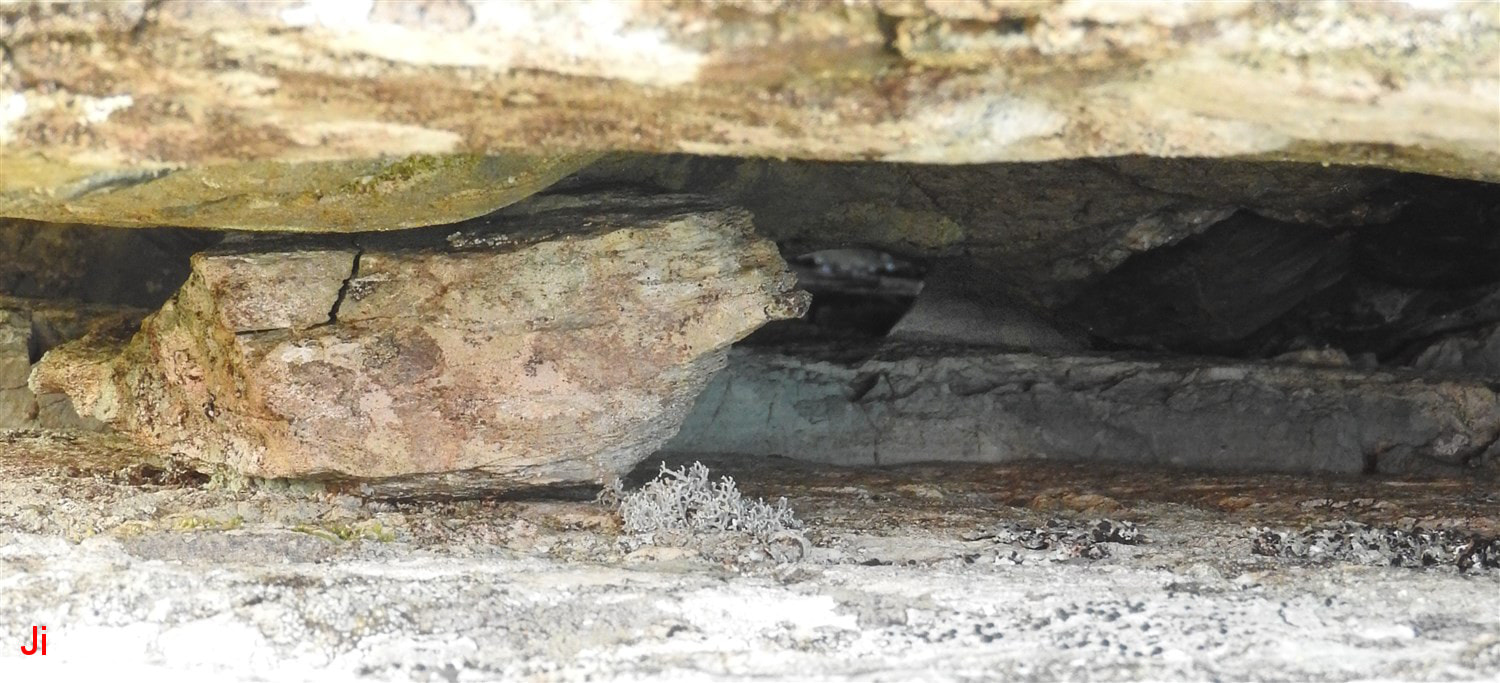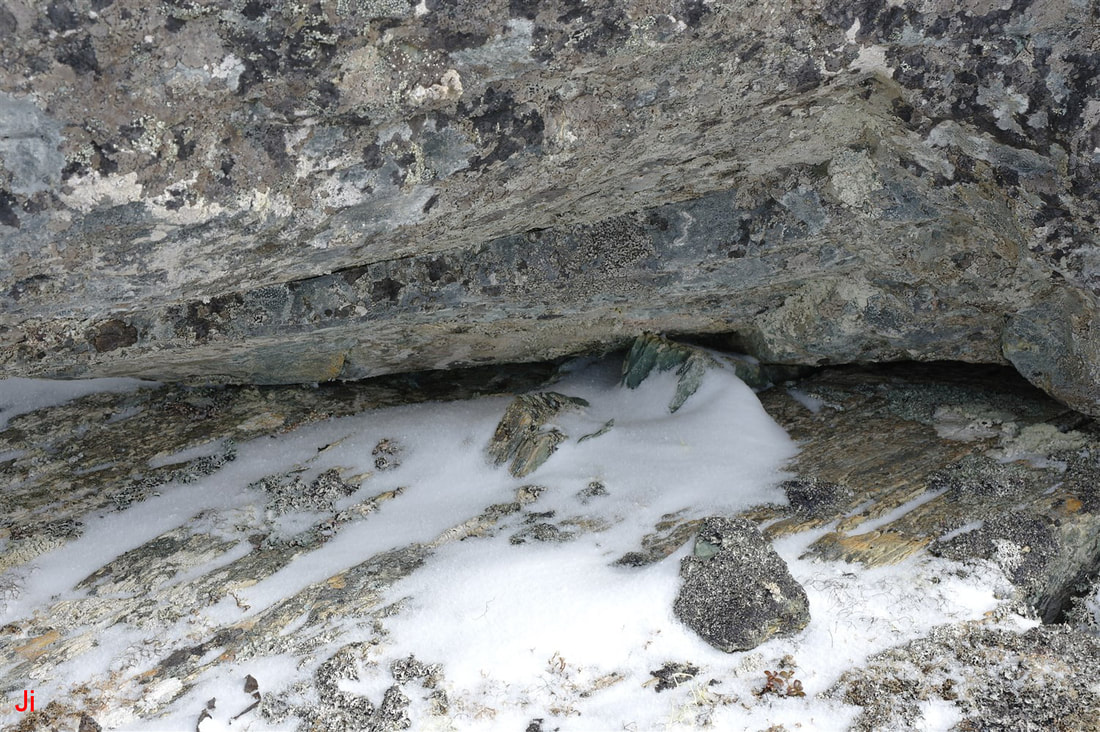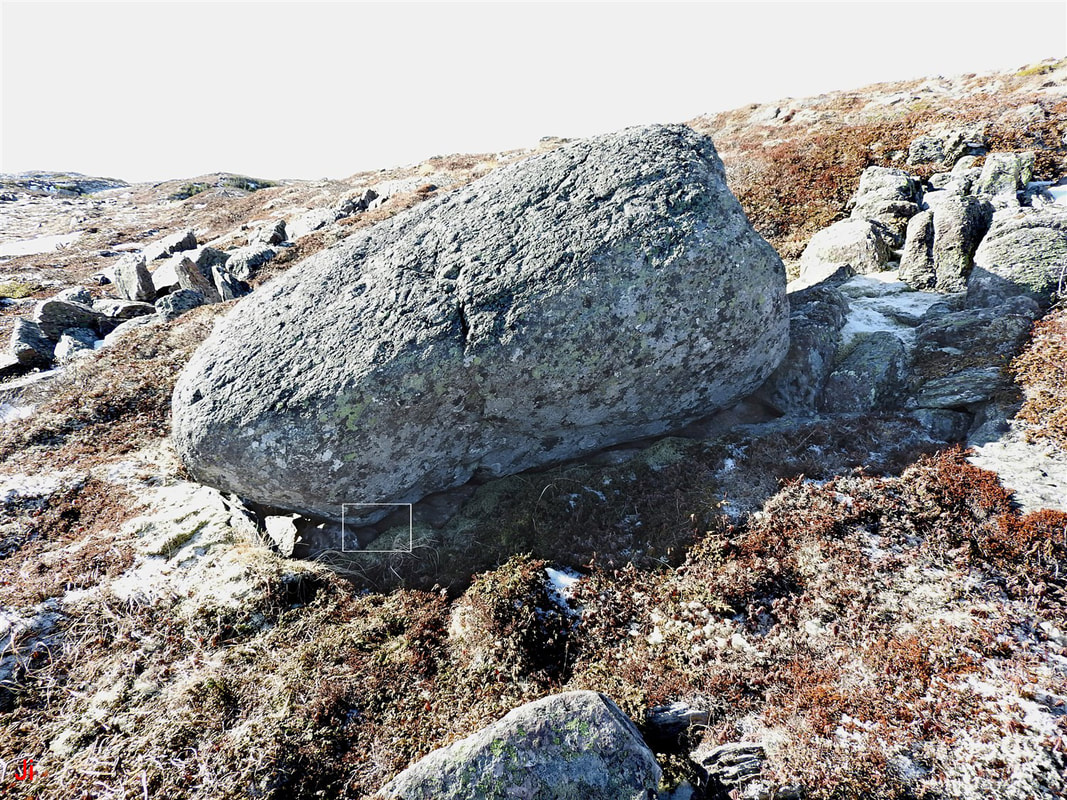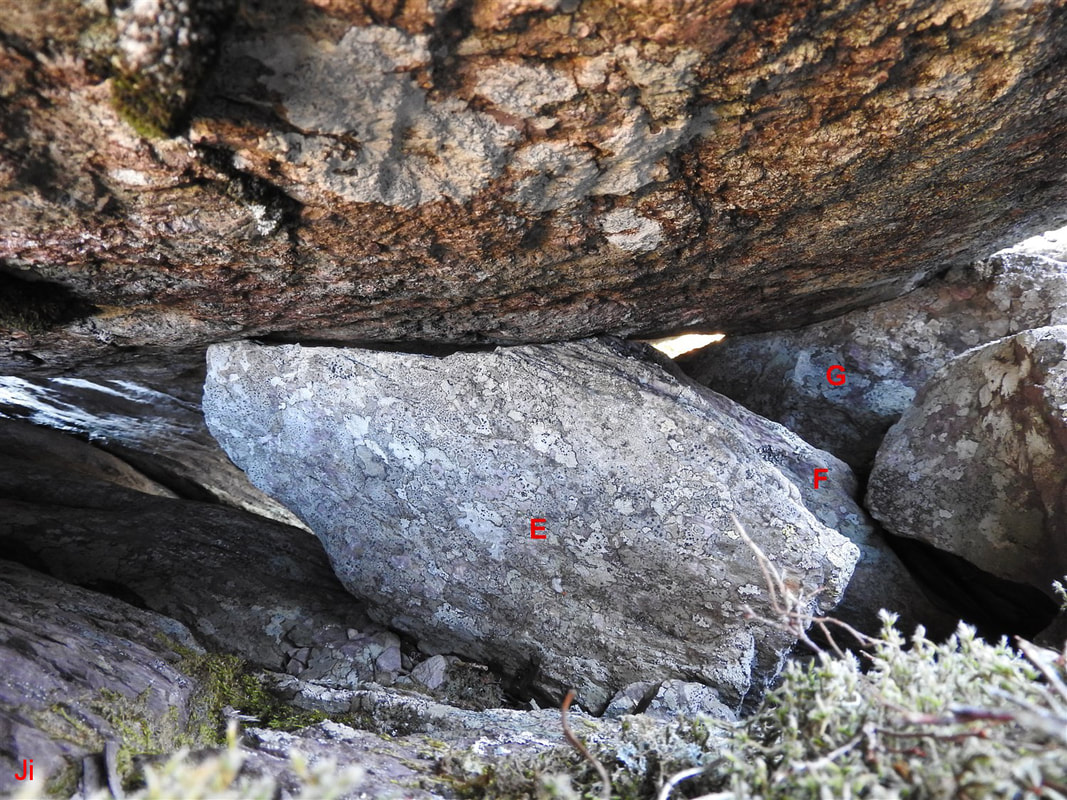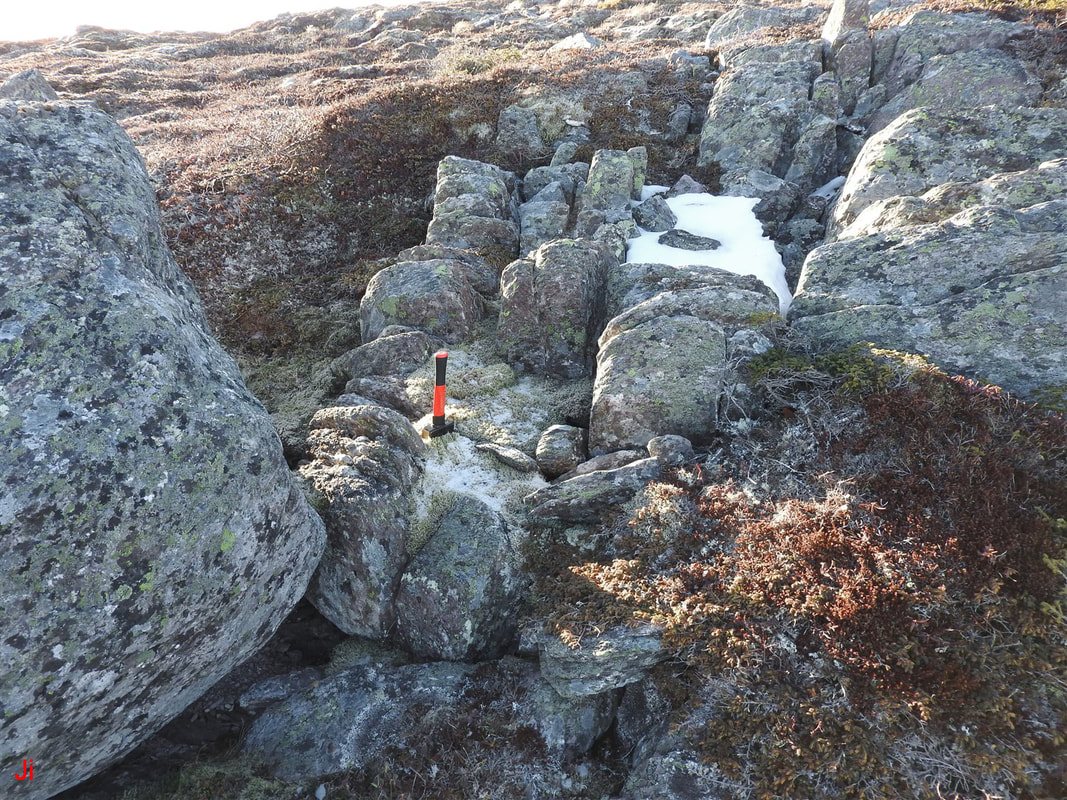| Heart of Avalonia |
Glacial Erratics and Bedrock Frost Heave: Event Sequencing - Part 2
This section presents two closely examined examples of erratics resting on frost-heaved bedrock. Both of the erratics included in this section were found in areas where nearby bedrock frost heave was particularly noteworthy in terms of the severity and diversity of the occurrences. Accordingly, the examples discussed below were examined in as thorough a manner as was practical. The intention in presenting these examples is to build confidence in the theory that bedrock frost heave on the Avalon Peninsula occurred largely in a subglacial environment.
For an introduction to the analysis of erratics resting on frost-heaved bedrock, see Glacial Erratics and Bedrock Frost Heave: Event Sequencing - Part 1. For additional examples of erratics resting on frost-heaved bedrock, see Glacial Erratics and Bedrock Frost Heave: Event Sequencing - Part 3.
Example 01:
The above photo shows a glacial erratic and frost-heaved bedrock. The view (looking south) shows the north side of the erratic boulder. The right-hand foreground of the photo includes an exposed area of glacially smoothed sedimentary bedrock. The bedrock is strongly foliated, with the foliation being tectonically aligned (strike northeast) and dipping vertically. Frost-heaved bedrock is seen in the center left of the frame and just above the center of the frame, in front of the erratic. The boulder is genuinely erratic (that is, not sourced in the immediate vicinity and differing markedly from the surrounding sedimentary bedrock). It is comprised entirely of andesite.
The above photo shows a closeup view of frost-heaved bedrock outcropping near the erratic. Note that some frost-heave blocks on the right have been entirely dislodged from substrate. The area surrounding the illustrated site incorporates numerous significant outcrops of frost-heaved bedrock, including large monoliths and clusters of layered monoliths. The photo below shows a group of layered frost-heaved monoliths in the immediate neighborhood of the above-pictured erratic.
|
This example of a layered frost-heaved monolith suggests a link between bedrock frost heave and the widening of joints in foliated bedrock. In many localities, joint widening is enhanced in blocks that have been displaced upward by bedrock frost heave. The link between joint widening and bedrock frost heave forms part of the Subglacial Ice Plume model.
|
The above photos show four sides of the erratic boulder. The indicated directions are view directions (directions in which the camera was pointing). Thus, for example, the south side of the boulder is shown in the photo marked "N".
A view of the south side of the erratic is shown above. As illustrated in the photo below, the boulder does not contact the frost-heaved blocks seen on the left. However, the blocks immediately to the left of the erratic may have been pushed downward by ice pressure related to intrusion of the boulder (see further discussion of ice creep beneath erratics in the last paragraph of this Example 01).
It was observed that the erratic did not lie on top of any large blocks of frost-heaved bedrock. However, a close inspection beneath the boulder showed that the boulder overlies some small frost-heaved bedrock features.
The above photo, taken looking north underneath the erratic, shows widened joints in bedrock (foreground), small fissures (right), and frost-heaved bedrock. Note the dislodged fragment appearing at the upper right in the photo. This fragment is pinned tightly between the overlying erratic and underlying bedrock. The block appears to partially bear the weight of the erratic. The fragment is of reasonable size, shape and composition to have originated from the nearby fissure. A closeup image of the fragment, seen in a view looking west, is shown in the photo below.
It is unlikely that the fragment shown above could have reached its present location with the overlying boulder having already been settled into position. Thus, if this fragment is of frost-heave origin, then the corresponding frost heave event preceded erratic placement and was therefore subglacial.
The above two photos (first looking north, second looking northeast) show closeup views of bedrock frost heave occurrences underneath the erratic. The first photo illustrates that rock fragments have been removed from fissures, presumably by glacial erosion prior to placement of the erratic. The second photo shows fragments of frost-heaved bedrock, some contacting the underside of the erratic, and some falling short of contact. The larger frost-heaved block (rightmost on second photo) has apparently been broken by the force of contact with the erratic. The broken fragments lie on the west side of the originating block. A closeup image of additional broken frost-heaved fragments is shown in the following west-directed view.
In the foreground of the above picture (view looking west), a level rail comprised of frost-heaved bedrock is seen just in front of taller, broken frost-heaved fragments. The broken fragments are visible just to the left of, and to the right of, the darker rounded section of rock protruding downward from the erratic. In both instances, the broken rock was deflected westward. The observations appear to favor a model where the erratic encroached on pre-existing frost-heaved bedrock, with the erratic moving slightly westward as it settled.
The above photo shows the northwest corner of the erratic, where a small occurrence of frost-heaved bedrock contacts the base of the overlying boulder. A closeup view is shown below.
The three points of contact between the erratic and the frost-heaved fragment suggest a fit formed under load. It is uncertain as to whether this fit resulted when the fragment moved upward (subaerial frost heave) or when the boulder moved downward (subglacial frost heave). Overall, the frost heaved blocks observed beneath the erratic seem subdued in height compared to frost heaved blocks occurring adjacent to the boulder. This observation applies to fragments beneath the boulder but not making contact, as well as to fragments making contact. A possible explanation follows from considering ice creep that occurs directly beneath the boulder as it settles. While such creep would necessarily be tangential to non-yielding bedrock, downward (nontangential) creep would be favored when bedrock could be driven downward. This situation might prevail when frost-heaved fragments were underlain by ice-filled cavities. It is reasonable to assume that rock can be pushed downward by highly stressed ice as well as by direct contact with a descending boulder.
Example 02:
Example 02:
The above photo shows bedrock, ice-disrupted and frost-heaved bedrock, and a large erratic boulder (above and to the right of center in the frame). The interaction of the erratic and underlying ice-disrupted bedrock was analyzed in detail at this site because of the significance of the surrounding area in understanding many key aspects of ice-bedrock interaction on the Avalon Peninsula. For example, the feature illustrated below lies nearby.
|
This nearby feature (about 5 m high overall) comprises a bedrock frost heave occurrence that, if demonstrated to be a relict subglacial ice plume feature, would be one of the best examples of this type of occurrence on the Isthmus of Avalon. |
The above photo shows the rounded, elongated erratic lying atop ice-disrupted bedrock on a gentle down-slope. Just up-slope from the erratic is a group of frost-heaved joint blocks. The erratic is composed of ignimbrite with large clasts, while the bedrock at this site is composed of a generally fine-grained tuff. Surface photos (taken at similar scales, field of view about 75 cm wide) of the erratic and the local bedrock are shown below. Based on a match of rock types, this erratic traveled at least 1 km before reaching its present site.
The above photo shows the dip of the pronounced, tectonically aligned foliation in the local bedrock. The pictured low, rounded bedrock outcrop incorporates joints that have been widened by frost wedging. The strike and dip of the foliation in the surrounding area are generally consistent with the above illustration.
The above layout diagram shows the orientation of the erratic boulder relative to the slope and the local foliation. An analysis of the rocks underlying the erratic is presented in the following discussion, starting with observations from the eastern corner. The main question to be considered in the analysis is:
Was it possible for the ice-induced bedrock disruption seen beneath the erratic to have occurred after the erratic settled into its present position?
Was it possible for the ice-induced bedrock disruption seen beneath the erratic to have occurred after the erratic settled into its present position?
The above picture of the southeast end of the erratic shows a contact between the erratic and frost-heaved bedrock. This contact is under significant load, with the erratic bearing downward on the frost-heaved block and applying torque that would tend to rotate the block top-southeast. Note the considerable open space beneath the erratic. This characteristic is common to the entire layout. A substantial volume of bedrock appears to have been removed from beneath the erratic by glacial erosion. This erosion would reasonably be assumed to have occurred prior to placement of the overlying boulder.
The group of rocks to be discussed below were observed by inspecting an area underneath the northeast side of the erratic and indicated by the white rectangle shown in the above photo.
The frost-heaved block "A" shown above is rotated about 30 degrees from its initial orientation and is pinned beneath the erratic.
The above southwest-looking photo shows the point of contact between block "A" and the erratic. This point of contact was determined to be under load. Rotated frost-heaved block "B" (background, left) does not contact the erratic.
The above two photos show block "A" viewed looking northeast, along with non-contacting rotated frost-heave blocks "B" and "D". Block "C" is a loose fragment. The conclusion taken from inspecting these blocks is that blocks A, B and D are rotated frost-heave blocks that would not have been able to reach their present orientation had the erratic been placed before frost heave occurred. This observation is particularly unambiguous in the case of block "A". In reaching the conclusion, it must be noted that blocks A, B and D are all assumed to be joint blocks, with their major front and back surfaces defined by foliation in the originating bedrock. Frost heave would drive these blocks upward with their major front and back surfaces inclined at 13 degrees to the vertical (see previously presented diagram showing angle of dip of foliation).
The above photo shows the southwest side of the erratic, underlain by 7 indicated frost-heave blocks. Blocks "4", "1" and "G" contact the erratic and appear to bear a significant portion of its weight. If the bedrock supporting the erratic were non-deformable, then the erratic would be expected to make contact under load at only three points. At least 6 major load-bearing contact points were observed beneath the boulder. This observation indicated that the supporting rock was deformable, as would be expected where frost-heaved support points are subject to being pressed downward into underlying cavities.
The above north-looking photo shows the south corner of the erratic where the erratic contacts block "G". Block "G" extends underneath the erratic where it makes a closely conforming abraded contact with the overlying boulder. The contact between block "G" and the erratic is seen in the following closeup photo, taken looking toward the southeast.
A high degree of conformity between block "G" and the overlying erratic is apparent in the above photo. A contact of this sort suggests that erosion via abrasion occurred during placement of the erratic. This type of observation reduces the chance that block "G" was forced into contact with the erratic by a frost-heave process occurring after the erratic was situated.
Frost-heaved blocks "E", "F" and "G" are shown in the above southeast-directed view underneath the erratic. Blocks "E" and "F" are both dislodged from bedrock, although the bottom right corners (direction as seen in the photo) of both blocks remain rooted in the cavities from which they were displaced. The photo below shows how these blocks apparently rotated in the plane of foliation.
The rotation of blocks "E" and "F" indicated in the above photo appears to have been caused by contact with the overlying erratic boulder. It does not seem possible for frost-heaved block "E" to have reached its present position and orientation via frost heave action occurring after deposition of the erratic. Blocks "E" and "F" were therefore deemed to represent likely occurrences of subglacial bedrock frost heave.
The above northeast-directed photo shows a tightly wedged fragment of rock pinned between block "1" and the overlying erratic. A detailed inspection of block "1" suggested that the fragment resulted from small-scale frost heave occurring on the top surface of block "1". A closeup view of the top surface of block "1" is shown in the first photo below, while a side-on view of the northeast side of block "1" is shown in the second photo below.
The above photos show a pattern of joint widening and small fissures in block "1" suggesting that small-scale frost-wedging/frost-heave was occurring on this block. Block "1" appears to make a load-bearing contact with the overlying erratic boulder.
A northeast-directed view underneath the erratic and roughly parallel with the bottom of the erratic is shown above. Blocks 1, E and G all make contact with the bottom of the boulder (photo below shows contact for block 1), while block 2 falls short of contact by about 3 cm and block 3 by about 6 cm.
Views shown above and taken underneath the erratic, first looking south, then looking northwest, suggest that blocks 1, 2 and 3 are separate blocks, not bedrock, and that block 2 has been raised relative to adjacent blocks, presumably by frost heave. The blocks shown have likely all experienced loading from above by ice pushed downward as the overlying erratic settled. Block 4 is a large block that contacts the erratic and bears a significant portion of the weight of the overlying boulder. It is possible that block 4 experienced frost heave, but has now settled back to its initial position in bedrock because of the large downward-directed load.
The photo above shows the point of intersection of blocks 2, 3 and 4. The top surfaces of the rocks shown near the intersection lie about 6 cm below the bottom of the erratic.
The point where block 4 makes contact with the erratic is shown above. There is little indication that block 4 presently lies in a shifted position. This block was thus used as an approximate reference to determine the shifts of adjacent blocks relative to bedrock.
The northwest end of the erratic is shown in the above downhill view. Note the row of frost-heaved joint blocks extending from the foreground of the photo to the erratic. It will be argued below that these frost-heaved blocks acted as an obstruction when the erratic was moving into its final position and that the blocks adjacent to the erratic were loaded horizontally by their interaction with the encroaching boulder.
A closeup of the north corner of the erratic is shown above. The quadrilateral outlined in grey follows the contour of the top of a group of frost-heaved blocks adjacent to the erratic. The two long edges of the quadrilateral were drawn roughly parallel to the foliation in the blocks. The strike of the foliation shifts by about 20 degrees approaching the erratic. The shift suggests horizontal loading of the group of blocks by the boulder, with the load concentrated on the right (direction as seen in the photo).
The north corner of the erratic, contacting frost-heaved bedrock, is shown in the above photo. The following photo shows a closeup view from a lower height where evidence of the ice-induced uplift of the front-most frost-heaved block is visible.
The white arrow in the above photo indicates the shift of a frost-heaved block that now contacts the erratic. The indicated motion, upward and toward the erratic, is the apparent result of frost-heave action. Either the frost heave occurred prior to the placement of the erratic (considered most likely), or else the frost-heave-induced motion of the small block would have forced a shift in the position of the erratic boulder.
The block marked "Frost-heaved bedrock" in the above photo is the same raised block as shown in the previous photo and indicated with a white arrow. The block number "4" corresponds with the numbering scheme used previously in this Example 02. Examination of the gap between blocks "Frost-heaved bedrock" and "4" suggests that these two blocks were joined together as one block before first, frost wedging and then, loading by the erratic separated them. The gap between the blocks implies that the raised block of frost-heaved bedrock was shifted several centimeters horizontally to the right (direction as indicated in the photo). Furthermore, the gap between the blocks diverges outward at an approximate 20 degree angle, as would be expected if the raised block was forced, through interaction with the erratic, to rotate 20 degrees about a vertical axis.
Summarizing the observations presented above as Example 2, it appears reasonable to conclude that frost heave and associated bedrock disruption occurred at this site before the erratic arrived. Glacial loading prior to arrival of the erratic could account for some of the observed rock shifts, but several shifts of frost-heaved blocks appear most likely to have been caused by direct interactions with the erratic boulder. In either event, the observed bedrock disruption would have occurred in a subglacial environment.
There is another question relating to the origin of the ice-disrupted bedrock observed at this site. Was the bedrock disruption caused by glacial plucking? Much of the ice-disrupted bedrock observed at the site consists of frost-heaved monoliths that were lifted approximately vertically. Glacial plucking is unlikely to account for the formation of frost-heaved monoliths.
Summarizing the observations presented above as Example 2, it appears reasonable to conclude that frost heave and associated bedrock disruption occurred at this site before the erratic arrived. Glacial loading prior to arrival of the erratic could account for some of the observed rock shifts, but several shifts of frost-heaved blocks appear most likely to have been caused by direct interactions with the erratic boulder. In either event, the observed bedrock disruption would have occurred in a subglacial environment.
There is another question relating to the origin of the ice-disrupted bedrock observed at this site. Was the bedrock disruption caused by glacial plucking? Much of the ice-disrupted bedrock observed at the site consists of frost-heaved monoliths that were lifted approximately vertically. Glacial plucking is unlikely to account for the formation of frost-heaved monoliths.
The frost-heaved monoliths shown above would probably have been rotated or broken loose and shifted downhill by downhill-moving glacial ice. They are not likely the result of glacial plucking.
The down-slope at this site shows elevation declining toward the east. Glacial plucking would thus entail an easterly directed ice flow (ice pressure declining eastward). However, the nearest coastline lies due west of the site and other ice-flow indicators in the area suggest westerly directed ice flow.
The snow-covered erratic is seen at the skyline about midway up the hill shown in the above photo. The hill terminates in a glacially plucked cliff situated west-northwest of the erratic. The cliff, pictured below, shows evidence of internal rock deformation suggesting ice pressure diminishing toward the west.
West is to the right in the above south-directed photo. This cliff, lying west-northwest of the erratic, shows a pattern of bedrock disruption indicative of ice pressure declining toward the west. With the erratic located on an opposite-directed down-slope about 50 meters to the east, glacial plucking becomes an unlikely cause for bedrock disruption at the site of the erratic. The rock shifts seen above might not represent plucking by a warm-based glacier, although evidence of large-scale plucking by warm-based glacial ice moving westward is indicated by other observations in this area. Some or all of the restricted rock rotations seen in the above photo might represent the action of a subglacial ice plume that occurred beneath a cold-based glacier during the Younger Dryas cold period. A similar origin could account for the bedrock disruption seen near the erratic.
heartofavalonia.org Exploring Geologic History







